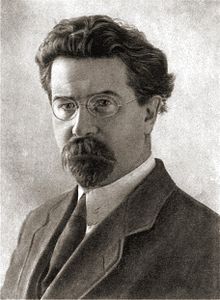Viktor Pavlovich Nogin
Viktor Pawlowitsch Nogin ( Russian Ви́ктор Па́влович Ноги́н ) (* February 2 July / February 14, 1878 greg. In Moscow ; † May 22, 1924 in Moscow) was a Soviet revolutionary, politician and the first people's commissar for trade and industry after the October Revolution .
biography
Before the revolution
Nogin, the son of a shopkeeper in Moscow, attended a school in Kalyasin , Tver Oblast , from 1892 . From 1893 he worked in a textile factory and from 1896 was an apprentice in the textile factory Pal in Saint Petersburg . There he organized strikes. He has acquired his further knowledge in self-study. The young worker joined the Social Democratic Labor Party of Russia (RSDLP) in 1898 and was active in Saint Petersburg. He was arrested and deported several times afterwards, including a. to Poltava in central Ukraine . In April 1903 he escaped from exile and then stayed abroad. Months later he returned to Russia and he was then the liaison for Iskra magazine .
In 1907 he and four other representatives of the Bolsheviks were elected to the 14-member Central Committee (ZK) at the Fifth Party Congress of the RSDLP in London . He also belonged to the then 15-strong headquarters of the Bolsheviks (BZ) and was named by Trotsky as one of the most important organizers .
Around 1910 he tried - but unsuccessfully - to get the leaders of the Social Democratic Labor Party, which was divided into Bolsheviks and Mensheviks , to work together again. He was one of the so-called “Compromisers” of the Bolsheviks. At that time Nogin organized the establishment of a "Russian office". In 1915 he wrote in a Marxist compilation edited by Lenin .
In 1916 he worked in Saratov and in 1917 in Moscow, alongside Bubnov and Rykov, one of the leaders of the Moscow Bolsheviks .
Revolutions in 1917 and after
In 1917 Nogin belonged to a leadership group of the Bolsheviks around Kamenev , Rykow, Dzerzhinsky and Angarsky, who advised caution in the revolutionary process of 1917 on the grounds: "The democratic revolution is not complete" , while Lenin in 1917 demanded and enforced more determination. At the fifth party congress of the SAPR on April 24, 1917 in Petrograd , Nogin was re-elected to the only nine-member Central Committee (ZK) headed by Lenin and in which Stalin was also to be found for the first time . In August 1917 he was a member of the committee in Saint Petersburg , which succeeded in suppressing an attempt at military resistance by General Kornilov and his troops around Saint Petersburg. Also the VI. At the beginning of August 1917, the party congress of the SAPR elected Nogin to lead after Lenin, Zinoviev , Kamenev and Trotsky in the then still powerful Central Committee. He belonged to the inner leadership circle of those who prepared the revolution. During the October Revolution he was sent to Moscow to organize the activities of the Bolsheviks.
After that, from October 1917, he was the first People's Commissar for Trade and Industry in the Council of People's Commissars in the government under Lenin. Soon there was a significant dispute over the involvement of other revolutionary groups in the work of government and executive bodies.
On November 17, 1917, Nogin, Kamenew, Zinoviev, Rykov and Milyutin resigned from the government chaired by Lenin as People's Commissars and / or from the Central Committee with the declaration:
“We take the position that it is necessary to form a socialist government from all parties represented in the Soviet. We believe that only the formation of such a government can secure the achievements of heroic struggle 〈…〉 The alternative to this, in our opinion, is a purely Bolshevik government that can only assert itself through political terror. "
After that, Nogin could no longer stay in the leadership circles of the CPSU , while Zinoviev and Kamenev and, a little later, Rykov and Milyutin only lost their offices under Stalin and their lives in the 1930s.
From October 25, 1917 to November 13, 1917, he was the first chairman of the executive committee (mayor since 1991) of Moscow after the revolution for a short time .
After this brief period in government, he campaigned for the expansion of the textile industry from November 1917. In 1923 he therefore also visited the USA in order to bring about cooperation between the industrial sectors. He also had mediating talks with US President Coolidge .
Honors
- Nogin was buried in the necropolis on the Kremlin wall on Red Square in Moscow.
- The city of Noginsk (formerly Bogorodsk) and the Noginsk Rajon in Moscow Oblast - around 50 km east of Moscow - were named after him.
- A station on two lines of the Moscow Metro on the square of the same name was named after him ( Ploschtschad Nogina ; the station has been called Kitai-Gorod since 1990 ).
literature
- Leon Trotsky: Stalin - A biography ; Pawlak-Verlag and Kiepenheuer & Witsch,
- Merle Fainsod : How Russia is governed ; Kiepenheuer & Witsch, 1965
Web links
| personal data | |
|---|---|
| SURNAME | Nogin, Viktor Pavlovich |
| ALTERNATIVE NAMES | Ногин, Виктор Павлович (Cyrillic); Nogin, Viktor Pavlovič (scientific transliteration) |
| BRIEF DESCRIPTION | Russian politician |
| DATE OF BIRTH | February 14, 1878 |
| PLACE OF BIRTH | Moscow |
| DATE OF DEATH | May 22, 1924 |
| Place of death | Moscow |
